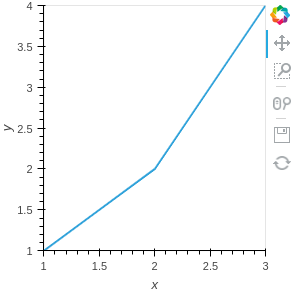HoloViews may become the standard for Python visualization tools
What is HoloViews
HoloViews is a wrapper that makes it easier to use visualization tools such as matplotlib and Bokeh in broken terms. Visualization can be implemented with unified code and simple description using any backend (matplotlib, Bokeh, etc.).
The learning cost of visualization is not very high, so by using HoloViews ** "Let's concentrate on the original data analysis and other tasks instead of wasting time writing visualization code" ** It seems to be a feeling concept. In particular, the syntax of matplotlib is often esoteric, so many people may be wondering, "Isn't it a little simpler?"
Back end
The following visualization tools can be used as a backend.
- matplotlib
- Bokeh
- Plotly(experimental)
Installation
When installing with conda
conda install -c ioam holoviews bokeh
If you use matplotlib or plotly for the backend described later, install it additionally.
conda install matplotlib plotly
When installing with pip
[2017/07/30 postscript] There seem to be some Options (http://holoviews.org/user_guide/Installing_and_Configuring.html), but try installing with'recommended'.
pip install numpy param
pip install 'holoviews[recommended]'
Install the package used for the backend. There is no problem if you exclude unused items from the installation target.
pip install matplotlib bokeh plotly
When installing the latest version
What is git? Those who say it is better to install with the above conda or pip.
git clone git://github.com/ioam/holoviews.git
cd holoviews
pip install -e .
Jupyter Notebook launch options
If the notebook version is 5.0, set the following startup options.
jupyter notebook --NotebookApp.iopub_data_rate_limit=100000000
In later versions, just jupyter notebook seems to be fine.
Backend settings
Specify the backend as an argument of the notebook_extension class.
import holoviews as hv
hv.extension('matplotlib')
When running on Jupyter Notebook, it can be set with cell magic.
%%output backend='matplotlib'
Try to output the graph
The following are all execution examples on Jupyter Notebook. matplotlib
import holoviews as hv
hv.extension('matplotlib')
curve = hv.Curve(([1, 2, 3], [1, 2, 4]))
curve

Bokeh
hv.extension('bokeh')
curve = hv.Curve(([1, 2, 3], [1, 2, 4]))
curve

Plotly
hv.extension('plotly')
curve = hv.Curve(([1, 2, 3], [1, 2, 4]))
curve

I was able to write the same code with any backend.
compose
I think many people say that arranging multiple figures with matplotlib was quite difficult. HoloViews allows you to arrange and overlay graphs simply by using operators.
Arrange with + operator
hv.extension('bokeh')
curve = hv.Curve(([1, 2, 3], [1, 2, 4]))
bars = hv.Bars((['a', 'b', 'c'], [3, 2, 1]))
curve + bars

* Overlap with operators
%%opts Scatter(color='green', size=10)
scatter = hv.Scatter(([1, 2, 3], [1, 2, 4]))
curve * scatter

Combine + and * operators
curve * scatter + bars

Features of HoloViews
HoloViews has various functions. If I have a chance, I would like to introduce them one by one.
- Drawing live data
- Processing and drawing of table data
- Processing and drawing of multidimensional data
- Extraction of drawing data
- Event handling
- Interactive and exploratory visualization
- Large-scale data using Datashader
-> Continued: Basic graph of HoloViews in one liner
Recommended Posts